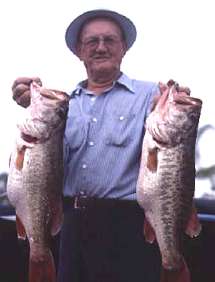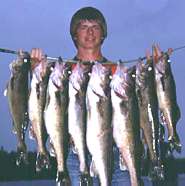|
|

|
 |
 | ||
Structure Must Be Our Fishing Guide
We must answer all successes and failures in terms of depth and speed control, using basic presentations of lures, which includes both casting and trolling. The basic presentation of lures, (depth and speed control) would not change regardless of the weather and water conditions, seasons, lake types, species of fish, etc. Many fishermen face unknown fishing conditions by planning to utilize some new electronic gimmick, "hot" lure, or some new fishing "breakthrough." Some might depend upon some new action, size, color, rattle, odor, or sound that's supposed to drive the fish crazy. It would probably be safe to say that most fishermen give some thought to what they will do, but very few know what they SHOULD do. Probably, many of us would not fish much if we did not know how weather and water conditions affected the movements of fish. Or, that a fish spent most of his time in deep water, and that he used the bottom features as guides in his movements and migrations. The "Basic Guideline" states it this way:
You will note the guideline made no mention about changing or bad weather conditions, "moods" of the fish, size, color, action, oxygen, pH, odor, casting ability, traffic, rigs, "method," "technique," or "patterns." These things are handled by the control of depth and speed of our lures. Depth control means where the fish will be. Speed control (how fast the lure moves through the water) is what makes the fish take the lure. Many misunderstandings are due to the fact that many fishermen do not know what the term "structure" truly means. Structure is a section of the bottom with some unusual features that distinguish it from the surrounding bottom area. We must note the word BOTTOM. It is not used just one time in this sentence; it is used twice. At no time did it say structure was a weed patch, bush, rock, stump, etc. The bottom of a lake, reservoir, stream, or pond with unusual features was what it said, and that is what it meant. There are approximately a dozen and a half bottom features (Structure Situations) the fish will use during their movements and migrations, regardless where we may fish. They are listed and explained in Buck's study material. It has been said when fish move (migrate) on structure, they will pause or stop at breaks and breaklines on the bottom structure. "Breaks" have been described as objects found on the bottom, such as rocks, stumps, bushes, weeds, washes, clear spots, etc. "Breaklines" are described as places on the bottom where there is a more sudden increase or decrease of depth. Although a "breakline" is a break, it is used as a separate feature, as it can be in the form of a weed line, edge of channel, or hole, a very obvious line around a structure or completely around a body of water. Or, it could be an "unseen" type breakline, such as color, temperature, light, current, etc. However, a "breakline" is normally thought of as a more sudden increase or decrease in depth (on the bottom), and as one of the more important "breaks" in fishing. Quite often we might say (or write)-"We must use bottom features in a body of water (structure, breaks, breaklines, deep water) as our guide as to where the fish will be." Then we might state it, or write it: "We must use structure (breaks, breaklines, deep water) as our guide." Then we might say: "We must use structure as our guide." Whichever way it is stated or written, it is correct. We could drop the words "deep water," for if we do not first accept the fact that deep water is the home of the fish (where they spend the greater part of their time), we might as well forget the rest of the stuff anyway. The key word in the whole thing is STRUCTURE. The use of 'breaks" and "breaklines" is completely secondary as to where you and I must look for the fish. Our first guide is "structure." The "breaks" and "breaklines" on, or connected to, the structure are where we "pinpoint" the fish. Many writers have shown maps and particular "structures" they have fished successfully. Many have gone to great pains to detail a particular feature, and how the fish use a particular spot. They have given in detail the type of lure, type of retrieve, "twitch," rigging, and even how the fish fought after being hooked. Anytime "structure" is talked about, the writer is doing the reader a favor, but too often he is guilty of saying too much about a particular situation. He may be complicating the whole thing by discussing too much about a particular structure, break, breakline, lure presentation, interpretation, etc. This may indicate he has forgotten that fishermen will be faced with a completely different weather and water condition, different seasons, different type lakes, different species, and definitely different moods of fish. Things change in fishing, and every fisherman should keep this is mind. What was great yesterday may not be worth a doodly-squat today or tomorrow. It is felt we should take a "high" look at a body of water (interpretation) and have a "bird's-eye view" for the presentation of lures. At times we should make a rough interpretation of the whole body of water, rather than a particular spot, and we should lay out the whole presentation of lures on a body of water, rather than one on a particular feature. In this way we may clear up what you and I will do when we plan a fishing trip, be it at a lake fished before, or a body of water never seen. This may cause more to understanding why it is said, "We must use 'structure' as our guide, and then use our 'tools' to control depth and speed (together at the same time) in order to arrive at the fish." How simple correct presentation of lures becomes. Experience over the years has caused us (Spoonpluggers) to refer to different portions of a body of water in different terms. One section will be referred to as "fishing water" and other sections as "trolling water." "Fishing water" is the area where there is the best chance to catch fish. We concentrate our efforts here. You may note a map of a lake may not show any well-defined structure, breaks, or breaklines or deep water in parts of the water and probably your depth sounder will not indicate any either. But smaller features not shown on the map, and things you can't see on the depth meter, could look like a "mountain" to a fish and also to your lures. These are "Trolling Waters." Do not pass up these areas for fishing. The fastest and easiest way to fish these areas and to find out what is actual there is by motor trolling. Our lures have to find the fishing spots. This is done by trolling contours with several different depth-running lures, being sure to check different speeds at each depth. We should also be sure the lures are lightly bumping, or as close to the bottom as possible. Depth control means where the fish may be. We should never forget that when on the water, trolling is our teacher. It will tell us where, when, what and how to cast. #### | |||
|
| |||
| Site design by Outdoor Management Network Inc. Copyright © 1996 - 2007 Outdoor Management Network Inc. America Outdoors® is a registered trademark of Outdoor Management Network Inc. |
 Much of the difficulty of finding and catching fish has to do
with the interpretation of water conditions. You and I must use
the features (structure, breaks, breaklines, deep water) in a
lake reservoir, pond, stream, etc.) as our guide to where the
fish will be. These features are to be used at all times, regardless
of the weather, season, lake type, or mood of the fish.
Much of the difficulty of finding and catching fish has to do
with the interpretation of water conditions. You and I must use
the features (structure, breaks, breaklines, deep water) in a
lake reservoir, pond, stream, etc.) as our guide to where the
fish will be. These features are to be used at all times, regardless
of the weather, season, lake type, or mood of the fish.